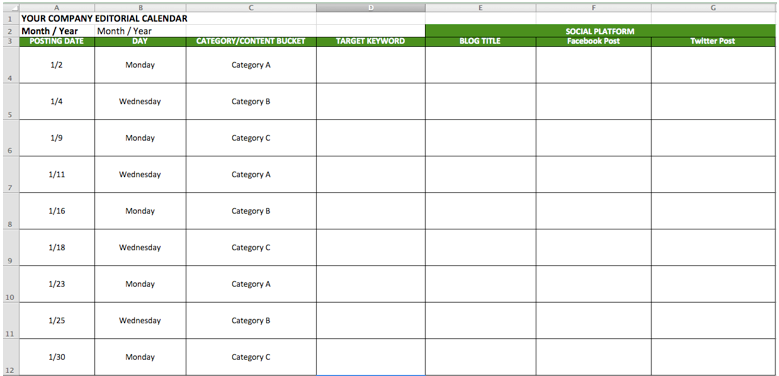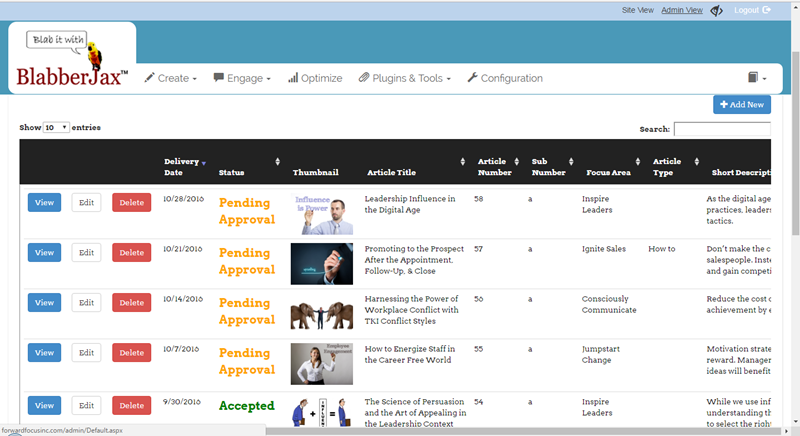If you’ve been looking for ways to draw more visitors to your website, you’ve probably run across the term inbound marketing content strategy.
Anything with the word “strategy” sounds pretty intimidating, right? Luckily for you, it’s not that complicated a concept (and it’s essential to your content strategy!)
Inbound marketing refers to marketing strategies that attract the customer to your website. Your goal is to provide valuable content to your prospective customer, and build a meaningful relationship, which increases your chances of getting a sale in the future.
So get ready to take notes (seriously, writing your strategy down is key to holding yourself accountable) while we dive into a few keys to an effective inbound marketing strategy.
Key components of an effective inbound marketing strategy
An Editorial Calendar
An editorial calendar is your way of tracking the content you publish across different platforms, such as your blog, social media outlets, and email list. You need to know which content is being published on which platform, and when.
Keep it simple. Start with a free resource like Google Calendars or an Excel spreadsheet. Take this one, from Sprout Content, for example.

You’ll want to include:
- The posting date
- The platform where you’ll post the content
- The type of content
- Target keywords
Writing it all down is crucial to keeping you on-task, so you can deliver regular content to the audiences who crave it.
But, if you find yourself too busy to create one yourself, consider using a content management tool like BlabberJax. Its built-in editorial calendar will give you control over your publishing schedule, and the best part? You won’t have to write anything at all.
A dedicated team member will work with you to develop a full-year calendar of blog posts that will get your business found by prospects. Then, as they’re completed, you’ll be able to review and approve each one before it’s published.

Buyer Personas
The more that you know about your ideal customer, the better you’ll be at attracting them. Here’s when buyer personas come in handy.
A buyer persona is just a fancy term for a hypothetical person created by you to represent the behavior and interests of your ideal customer.
Some basic information you should know to form your ideal persona:
- Age and gender
- Location
- Employer and salary level
- Family life and hobbies
- Goals and challenges (this one is the most important!) - What problems does your ideal customer have that you can solve?
Okay, but where do you find this information about your customers?
Start with your website analytics. If you don’t have any yet, start with Google Analytics. It’s used by all the pros, and it’s free.
You can also run an online survey, or conduct phone interviews. Ask your customers open-ended questions like: what’s your biggest challenge right now?
But don’t stop there. The more you know about your ideal customer, the more relevant your content will be to them.
Promotion
The key here is to not spread yourself too thin. Start with a blog, and one or two social media platforms. Think, “where does my ideal customer hang out on social media?” Use your buyer personas as a guide.
How can you figure out which social media platform you should focus on?
Here’s a snapshot of your social media options:
Use Facebook to:
- Build brand awareness among relevant audiences
- Establish your reputation as an industry authority
- Share personal stories and interact with your audience in-depth
Use Twitter to:
- Share quick news, updates, and react to real-time events
- Interact with other influencers in your field
Use Pinterest to:
- Share evergreen, inspirational, visual content
- Drive people back to your website through blog posts with highly-targeted keywords
- Feature products
Use LinkedIn to:
- Showcase your professional skills and build your reputation
- Establish yourself as a thought leader
Just remember, different audiences hang out on different platforms. And different platforms are best used for different purposes. Before you go investing time and money into one, do a little in-depth research.
Keyword optimization
Publishing regular content is great, but only if people get to read it. Attracting those people is where the “inbound” of “inbound marketing strategy” comes in.
To attract internet searchers, you need to pepper your articles with target keywords – so that when people Google a term that’s relevant to your business, they’ll discover your content.
Some basics:
1. Pick a keyword.
Think about the words people might use when searching for your website. Type them into Google and see what other kinds of content come up on page 1. Look to the bottom for related terms and consider using those as well. For a more detailed strategy, try using Google’s Keyword Planner tool.
2. Use your keyword strategically in the body of your post.
Don’t fill your post with your target keyword. That’s called “keyword stuffing,” and Google’s algorithm will penalize your site for the practice, making it even more difficult for people to find your site. Instead, pepper your keyword throughout, and add a few synonyms to please Google’s LSI technology.
3. Put your keyword in your post URL, the Title tag, the Meta description.
In the mind of a search engine “spider,” Google’s robot minions that “crawl” a web page to determine where it should be indexed (ranked in search results), if your keyword is in an important spot on the page, it must be central to the content. Make sure that keyword is in your URL, the title of your page, and in the meta description for best rankings.
Overall, the biggest thing to remember here is this: Write for people first, search engines second.
What’s your content marketing strategy?
Get all that down? Good.
Subscribe below for the next post in our content marketing series, in which we’ll talk about exactly the kind of content you should be creating for your audience.
In the meantime, let me know in the comments what your biggest challenges to inbound marketing success are. I read every one.